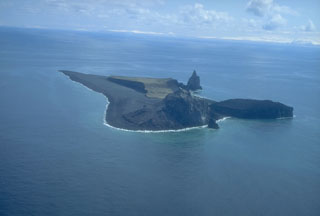Report on Bogoslof (United States) — 1 February-7 February 2017
Smithsonian Institution / US Geological Survey
Weekly Volcanic Activity Report, 1 February-7 February 2017
Managing Editor: Sally Sennert.
Please cite this report as:
Global Volcanism Program, 2017. Report on Bogoslof (United States) (Sennert, S, ed.). Weekly Volcanic Activity Report, 1 February-7 February 2017. Smithsonian Institution and US Geological Survey.
Bogoslof
United States
53.93°N, 168.03°W; summit elev. 150 m
All times are local (unless otherwise noted)
AVO reported that no further emissions were detected at Bogoslof after an explosion at 0520 on 31 January; the Aviation Color Code (ACC) was lowered to Orange and the Volcano Alert Level (VAL) was lowered to Watch the next day. A burst of tremor lasting nine minutes was detected starting at 0457 on 3 February. A second burst, starting at 0533 and lasting 20 minutes, was also detected by infrasound instruments, indicating an explosion. No ash cloud was detected above the meteorological cloud deck in satellite data. An event that began at 1642 produced a small volcanic plume that drifted about 40 km N below an altitude of 7.6 km (25,000 ft) a.s.l. Seismic tremor significantly decreased later that evening. Weakly elevated surface temperatures were observed in two satellite images acquired on 5 February, possibly related to hot deposits from explosive activity the day before.
Geological Summary. Bogoslof is the emergent summit of a submarine volcano that lies 40 km N of the main Aleutian arc. It rises 1,500 m above the Bering Sea floor. Repeated construction and destruction of lava domes at different locations during historical time has greatly modified the appearance of this "Jack-in-the-Box" volcano and has introduced a confusing nomenclature applied during frequent visits by exploring expeditions. The present triangular-shaped, 0.75 x 2 km island consists of remnants of lava domes emplaced from 1796 to 1992. Castle Rock (Old Bogoslof) is a steep-sided pinnacle that is a remnant of a spine from the 1796 eruption. The small Fire Island (New Bogoslof), about 600 m NW of Bogoslof Island, is a remnant of a lava dome formed in 1883.
Source: US Geological Survey Alaska Volcano Observatory (AVO)

